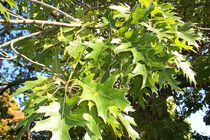

Permission: Some rights reserved
Northern pin oak
It is a medium-sized deciduous tree growing to 20 m tall with an open, rounded crown. The leaves are glossy green, 7-13 cm long and 5-10 cm broad, lobed, with five or seven lobes, and deep sinuses between the lobes. Each lobe has 3-7 bristle-tipped teeth. The leaf is nearly hairless, except for small tufts of pale orange-brown down where the lobe veins join the central vein. The acorns tend to be ellipsoid , though they tend to be highly variable and range to globose, 6-11 mm long and 10-19 mm broad, a third to a half covered in a deep cup, green maturing pale brown about 18 months after pollination; the kernel is very bitter. The inner surface of the acorn cap is glabrous to sparsely or moderately pubescent, and the hairs if present tend to be kinky rather than straight.Northern Pin Oak (Quercus ellipsoidalis) is very common in West-Central Wisconsin and the Twin Cities of Minnesota. It is more common than the Northern Red Oak (Q. rubra) in the eastern part of the Twin Cities. Regional... More
The Northern Pin Oak or Hill's Oak (Quercus ellipsoidalis) is an oak in the red oak section Quercus sect. Lobatae. It is mainly native to the northern midwest United States, and also in the southeast and southwest of Ontario, Canada. It occurs on dry, sandy, usually acidic soils. Although the name suggests an alliance to the Pin Oak Q. palustris, it has traditionally been thought to be closely related to the Scarlet Oak Q. coccinea, and was in fact included in that species by many botanists. More
* Like several other oaks, northern pin oak can be used to make furniture, flooring, and interior finishing. * Hill's oak wood is heavy and strong. It is used in the manufacture of shingles and for interior finishing. Reproduction: * Sexual: Northern pin oak is monoecious. Seed production begins when the tree is about 20 years old. More
